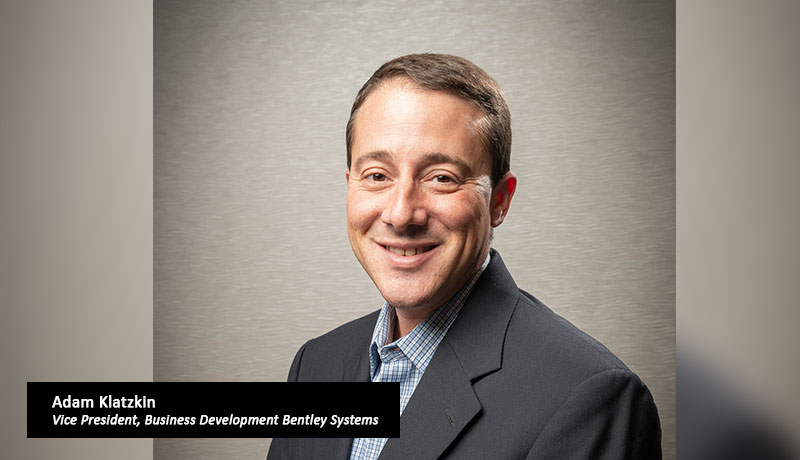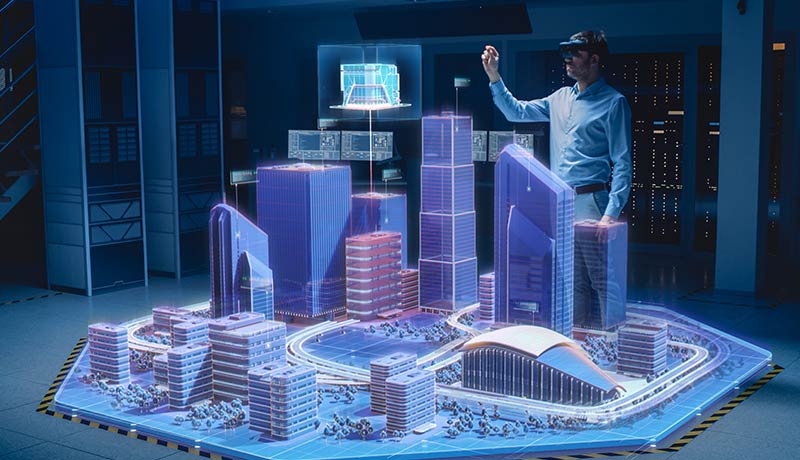
TECHx spoke to Adam Klatzkin Vice President, Business Development Bentley Systems to learn about the widespread deployment of emerging technologies in the construction industry and how digital twins are reimaging the construction industry.
TECHx: Considering the widespread deployment of Artificial Intelligence, IoT & Automation in construction projects during 2020, let’s start by talking about the impact of digitalization on the construction industry.
Adam: Yes, there is no doubt that there are a lot of users digitalizing their workflows, including implementing digital twins. It is a rapidly growing market, and we see some interesting third-party research showing that the digital twin market will soon surpass that of BIM. This does not mean, however, that BIM is going away. Digital twins will not replace BIM but will advance and complement it, and enable further digital transformation. When we look at who is driving the adoption of digital twins, most of the initiatives are by owner-operators, but there is a significant drive within engineering service firms, especially in the transportation sector. This sector is a leader of digital twin adoption, closely followed by plants, particularly oil and gas and chemical, metals, and mining.
TECHx: Digital twins were a hot topic in 2020, but few really understand what they are and what they can do. Could you please tell us what are digital twins and how they are reimaging the construction industry?
Adam: A digital twin is a digital representation of a physical asset at the moment. You can leverage the digital twin to understand what is happening with real-world assets in real-time, giving you visibility into these assets without having to leave the office. Digital twins help you collaborate more easily and more effectively with distributed teams or stakeholders and, ultimately, enable you to make more informed decisions and improve the performance of your infrastructure.
The relationship between a digital and physical asset should be symbiotic. The analysis and insights that happen within a digital twin become actions and interventions that feedback to the physical asset, resulting in outcomes or changes to the digital twin. Ultimately, organizations leveraging digital twins will not only reduce costs and risks for a single asset. Their digital transformation will also allow them to optimize performance across an entire portfolio, as well as future projects based on lessons learned.

Adam: There are two realities that we need to recognize. The first is that infrastructure projects have massive amounts of data, which is typically understood by a single application or expert user and not available in other contexts. To compound it further, the data is always changing as the project progresses. The second reality is that these projects tend to store data in multiple, siloed data sources, making it even more difficult to track and manage data.
Digital twins need to handle these massive amounts of data while bringing it all together in a single view. The digital platform needs to align and federate data.
Users begin creating a digital twin by first developing a reality model. The team provides data about the physical location of the site where the bridge would be constructed. Team members would use a reality capture via unmanned aerial vehicles to establish a reality mesh or use their reality capture data in combination with map and terrain data. All data would be brought together to show true site conditions as the model is continuously surveyed and synchronized.
As the bridge project progresses, the files will likely reside in a connected data environment. Connections are then established between the model and the files in that connected data environment. Now, you have a digital twin that uses the data to detect changes. It is aligning disparate data together into a single digital representation of the physical bridge that you’re engineering and showing you the changes as they come in. The digital twin can validate the trustworthiness of that data through data quality services, which are all automated and validated against codes and standards that you input.
Adam: Digital twins present a new business opportunity for the infrastructure industry. Many of the users that we have spoken to see digital twins as a way to deal with challenges, such as an aging workforce, a skills shortage, and shrinking profit margins. There is an opportunity not just to do things more effectively and efficiently, but also to create a new business model where they start delivering digital twin services to clients and, therefore, expand more into operations and maintenance because they have more data to support these phases.
It is important to get started using digital twins as quickly as possible to avoid being left behind. We really encourage everyone to take a look at digital twins, find that low hanging fruit on those lighthouse projects, and get started now.
